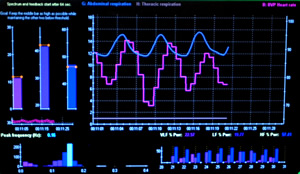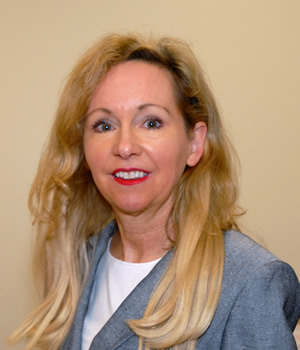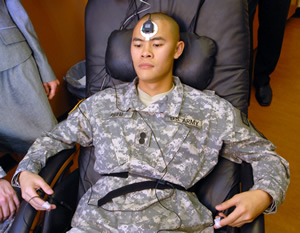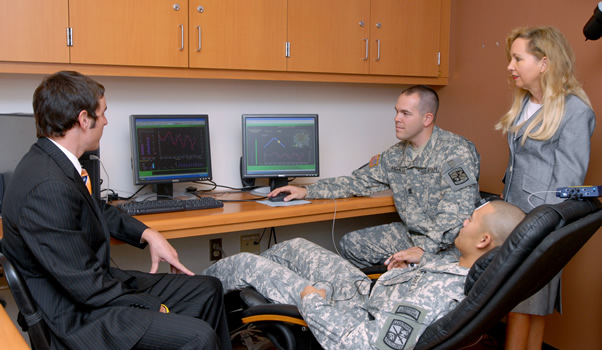Mind Over Body
Biofeedback Lab Helps Eliminate Anxiety, Fear, Pain
March 3, 2009
By Mimi Ko Cruz
When 2nd Lt. Jacob Gonzales first boarded an Army CH-47 Chinook, he got sick with nausea.
With a history of motion sickness, the officer said he had to figure out a way to control it to be an effective leader. “When you’re in charge of soldiers, it’s not good for them to see their leader vomiting in front of them,” he said from Fort Sill in Oklahoma, where he is awaiting deployment to Afghanistan.
Last year, while completing his psychology degree, Gonzales signed up for Maureen Haney’s biofeedback class, where he learned to control motion sickness.
What is Biofeedback?

The term was coined in 1969 to describe laboratory procedures that trained research subjects to alter brain activity, blood pressure, muscle tension, heart rate and other physiological responses often thought to be beyond voluntary control. Biofeedback helps teach people to improve their health and performance by observing signals generated by their own bodies.
“After I learned about biofeedback and techniques for concentrating, breathing and relaxing, I was able to use it, and it worked,” Gonzales said. “I also use it when I’m running five miles a day. It helps me with the pain so I’m able to push through to the end.”
Haney, lecturer in health science and director of the university's Psychophysiology Lab, said biofeedback is a learning process in which people are taught to improve their health and performance by observing signals generated by their own bodies. Her students learn to use biofeedback equipment and skills — such as deep breathing, relaxation, autogenics (self-hypnosis of the central and autonomic nervous system) and visualization — for changing physiological functions.
Biofeedback involves measuring brain waves, blood pressure, heart rate variability, skin temperature, sweat glands and muscle tension via sensors, or electrodes, placed on the skin, Haney said. The information is conveyed through computerized graphs and charts on state-of-the-art biofeedback equipment made up of Thought Technology's Infinity units and EmWave units by HeartMath.
Biofeedback therapy is used by such agencies as NASA, the military, hospitals and alternative medicine clinics.
“It’s very intensive training,” Haney said about the process. Her classes, Health Psychophysiology I and Health Psychophysiology II, and a related research lab were created in 2006 and 17, mostly undergrads, have enrolled. The students this semester include a couple of registered nurses, a psychology major, two health science majors, two kinesiology majors and a graduate student majoring in gerontology.
“You can learn to self-regulate with biofeedback by using your mind,” Haney said. “It’s not a quick fix, but you can train yourself to control physiological responses to such things as anxiety, anger, pain or stressful conditions or situations.”
About the Director

Maureen Haney joined Cal State Fullerton as a lecturer in health science in 1988. In 2006, she became the director of the newly created Psychophysiology Lab.
Previously, Haney worked as director of research, education and marketing at St. Jude Heritage Health Foundation in Fullerton, director of psychology and biofeedback at Fullerton Internal Medicine Center, a behavior education counselor for Nutri/System Weight Control Center in Huntington Beach and a research associate with the Veteran's Administration Medical Center in Long Beach.
She is a certified biofeedback practitioner and a certified stress management educator.
Haney, who received her master's in clinical psychology from Cal State Long Beach and her bachelor's in psychology from the College of New Jersey, has made presentations on her biofeedback research nationwide. Her most recent talk was delivered at the War-Related Illness and Injury Study Center in East Orange, N.J.
Director's Drive
Haney, who has scoliosis, should know.
She employed what she knew about biofeedback therapy after undergoing two painful surgeries.
"I had a 12-inch steel rod inserted in my back along my spine and segments of seven ribs were removed in 1978," Haney recalled. "Spinal segmentation was not as advanced then, so remaining in bed for three months, post surgery, in a body cast was required. In 1992, I slipped, fell and the rod was dislodged and I had another surgery.
"I requested minimal pain medication after my first 13-hour surgery but never activated the patient-controlled analgesia pump, following my second surgery," she added. "The initial surgery was especially difficult. My first thought was to quickly request pain medication. Fortunately, I was able to refocus and utilize self-regulation skills that allowed me to deal with the intensity of the post-surgical pain."
The experience, she said, "makes me passionate about the power of the mind to regulate physiology."
That explains why she pursues biofeedback research and is a strong advocate for it. She said plans are underway for clinical trials ranging from heart rate variability biofeedback for various medical conditions to resilience training for military personnel. The studies will involve collaboration with multiple agencies.
"The field has many possibilities and opportunities," Haney said, adding that interest in complementary medicine continues to grow and career options in biofeedback are expanding.
From Training to Workforce
Lee Zambrana, one of Haney’s first biofeedback students, completed his bachelor’s degree in psychology last semester and recently landed a job in St. Jude Medical Center’s Chronic Pain Program as a biofeedback specialist. He now is planning on taking the Biofeedback Certification Institute of America exam for national certification.
Haney’s “classes really prepared me for my job,” Zambrana said. “The demand for biofeedback therapy is on the rise with patients seeking alternative methods for dealing with pain.”
Indeed, said Haney, who offers biofeedback services to community members, ranging from those with general stress disorders to individuals dealing with fibromyalgia, through her lab’s Energy Management Training Program. The program consists of six sessions and costs $100.
Military Aid

ROTC cadet Minh Pham is connected to sensors ready for his biofeedback session. Photo by Kelly Lacefield
For the university’s Army ROTC cadets, the lab offers its Performance Enhancement/Resilience Training Program. Cadets in the program are given a psychophysiological stress profile and biofeedback training sessions designed to modulate stress reactivity and promote automatic nervous system flexibility.
“It is a skills building program that fosters the development of emotional and physiological self-control,” Haney said.
Having biofeedback training available on campus benefits the students, as well as the community, said Roberta E. Rikli, dean of the College of Health and Human Development.
"We offer this great service that helps people with their stress issues, while teaching our students how to use the equipment and preparing them for specialized jobs in the field," she said.
"We're one of the few schools in the country that provides the biofeedback certification program, thanks to Maureen's hard work setting up and offering the courses and the lab," Shari McMahan, professor and chair of health science and director of the university's Center for the Promotion of Healthy Lifestyles and Obesity Prevention.


